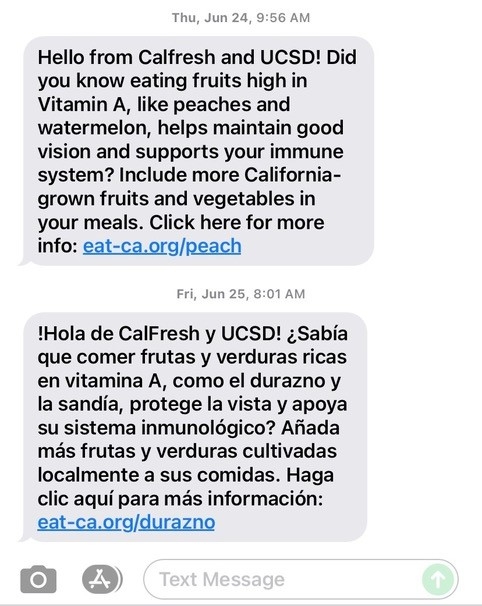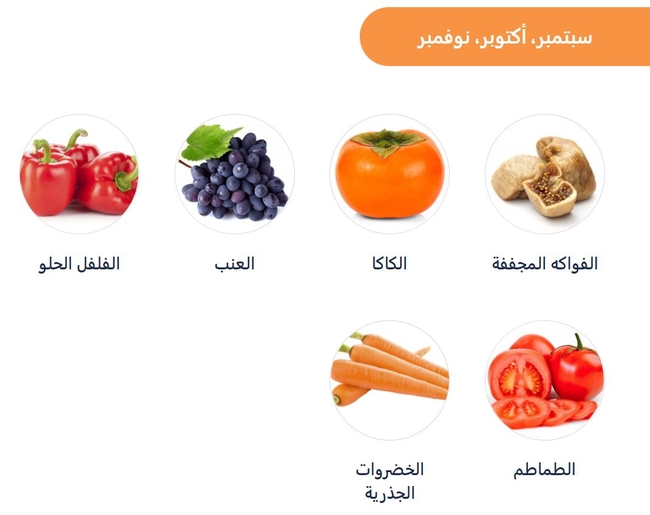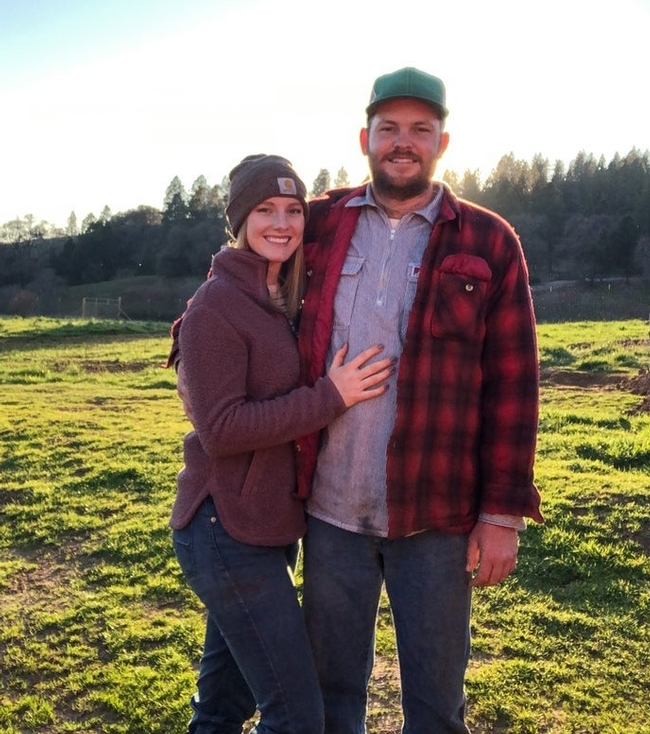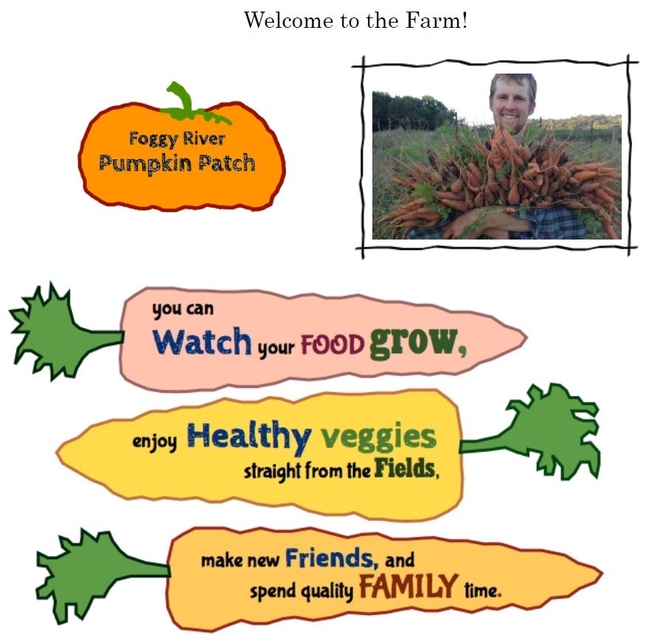- Author: Mike Hsu
The buzz or chirp of an incoming text message started some San Diego County residents on the path to a healthier diet during this past year. In September 2020, most CalFresh participants in the county – more than 172,000 households – began receiving monthly text messages about the benefits of California-grown fruits and vegetables as part of a pilot program.
This novel approach to delivering nutrition messages to California food assistance program participants was developed by a partnership of the Nutrition Policy Institute of UC Agriculture and Natural Resources, the UC San Diego Center for Community Health and the County of San Diego Health and Human Services Agency, which administers CalFresh in the county.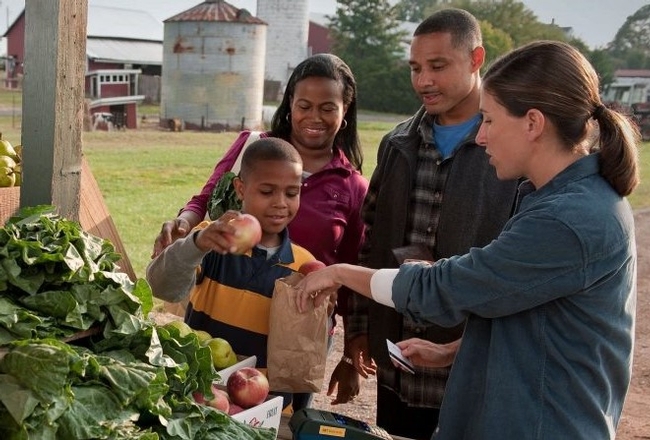
The HHSA, which had been using its text messaging platform to send administrative reminders and alerts, was receptive to using the tool for sending nutrition-focused information. NPI and CCH partnered with ideas42, a firm that applies behavioral science to solutions for social change, to develop a series of five text messages promoting California-grown fruits and vegetables.
The text messages – originally delivered in English and Spanish, with the addition of Arabic beginning in July 2021 – were friendly and conversational in tone.
“In a text, you have very few characters you're communicating with people, so we wanted to make sure we were using cutting-edge behavioral science to construct those messages to have the most impact,” said Wendi Gosliner, NPI senior researcher and policy advisor.
Each text included a link directing recipients to a website developed as part of the project, with information on selecting, storing and preparing California-grown fruits and vegetables; health benefits; tips to reduce food waste; and recipes – including TikTok videos.
Initially running from September 2020 to March 2021, the pilot program was well-received. Nearly 90% of CalFresh participants responding to a survey said they appreciated receiving the texts. “It is very important for us to eat healthy, to teach our children to eat healthy,” wrote one participant. “I love the recipes…they're so delicious and easy to make…I'm very, very grateful for the help because without you guys, I would be struggling more and I just want a better life for my children.”
Gosliner said it was encouraging to see that two-thirds of the approximately 5,000 survey respondents reported eating more California-grown fruits and vegetables after receiving the messages, and 85% expressed a desire to see more texts.
“What we see is that there's definitely a decent-sized population of people participating in CalFresh –now this is just in San Diego County but imagine the entire state – who would benefit from having this kind of information available to them,” Gosliner said. “And there is at least a subset of people who really liked it.”
UC San Diego's Center for Community Health was instrumental in facilitating the partnership between UC ANR and the HHSA. Further, CCH, in partnership with the San Diego County Childhood Obesity Initiative, formed a community council composed of residents representing diverse communities throughout San Diego County. Together, the council facilitated CalFresh participants to take part in focus groups, which provided feedback and guidance on the messaging and design for online resources. Gosliner said the success of the text program has been a direct result of community input and involvement.
“The Center for Community Health-led focus groups were integral to ensuring CalFresh resources were accessible and informative to a wide range of CalFresh participants, and local individuals and families more broadly,” said Blanca Meléndrez, executive director at the UC San Diego Center for Community and Population Health, Altman Clinical Translational Research Institute. “In the process, the text-based campaign also placed a greater focus on the local production of nutritious fruits and vegetables, ensuring access to healthy and nutritious food in all communities, and building new streams of income for the region's farmers and producers.”
This effort also suggests a simple way to reach CalFresh participants and bridge gaps between the Supplemental Nutrition Assistance Program and programming that offers nutrition education and healthy eating resources.
“By combining UCSD and UC ANR knowledge about healthy eating with our outreach capability, we are able to reach thousands of families via text message each month,” said Michael Schmidt, human services operations manager for the HHSA. “With the click of a button, these families are provided with resources to assist them in making healthier lifestyle choices, supporting a region that is building better health, living safely and thriving.”
The effort has been so effective that HHSA has asked for additional messages, beyond the original five months' worth of texts and resources.
“The partnership between UC ANR's Nutrition Policy Institute, UC San Diego's Center for Community Health, the County of San Diego Health and Human Services Agency and San Diego County community residents brought together a great team to develop an innovative, technology-based intervention,” said Shana Wright, San Diego County Childhood Obesity Initiative co-director at CCH. “Each partner provided knowledge, resources and assets that enhanced the project beyond the initial pilot phase, exceeding preliminary expectations.”
Gosliner said the pilot program has been a “great example and wonderful experience” of partnership in action.
“You can sit with your research or program ideas for a long time but if you don't have people who can help you implement them, then they really aren't helpful in any way,” she said. “In this case, it was just a nice combination of an idea…with partners who wanted to work to make something happen.”
- Author: Rachael Callahan
- Author: Cooper Limon
The COVID-19 pandemic hit farmers hard. Supply chains were disrupted and even non-traditional agritourism revenue streams such as hay mazes and on-farm events had to be canceled due to shelter-in-place mandates.
On the other hand, demand for local farm products skyrocketed, and thus many farmers and ranchers needed a quick pivot strategy and a set of new skills.
UC Sustainable Agriculture Research and Education Program (SAREP) was well-positioned to support this shift toward direct sales, pulling in trusted community partners and experienced farmers and ranchers to put together a comprehensive webinar series, “Agritourism and Direct Sales: Best Practices in COVID Times and Beyond”.
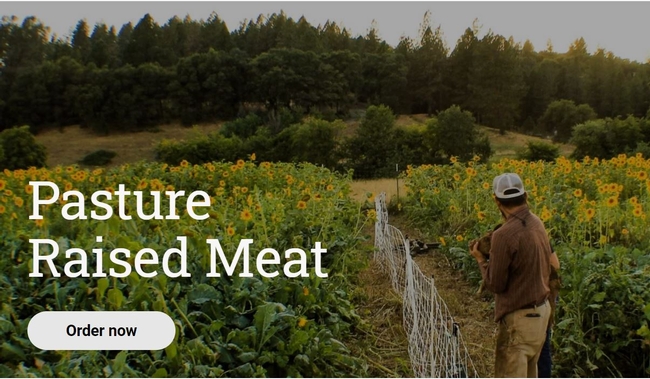
Funded by a USDA Farmers Market Promotion Program (FMPP) grant, the webinar series is part of a three-year project, Strengthening California Local Food Networks with Agritourism and Direct Sales, which provides trainings and technical assistance to farmers and ranchers on how to diversify their revenue streams.
The strength of the series, which includes eight webinars that were recorded earlier this year and are available online, lies in the collaborations among the UC SAREP Agritourism Program, UCCE, community groups, and farmers and ranchers.
The series features a range of speakers, including representatives from community organizations, technical experts, academic researchers, and farmers – all coming together to build resilience and adaptability for small-farming operations and the agritourism industry across California during the pandemic and after.
“It's great to collaborate with other organizations and regions, to learn from each other and to broaden our networks, as we are all working to create more resilient and sustainable food systems,” said Carmen Snyder, executive director of Sonoma County Farm Trails, one of the nonprofit partners on this project.
And because of those strong partnerships, the webinar topics reflected the on-the-ground needs facing agricultural producers.
“COVID initially dramatically affected farmers' restaurant contracts, with many losing more than 80% of their accounts overnight,” Snyder said. “CSAs [Community Supported Agriculture], on the other hand, couldn't keep up with the demand, and all of our CSA members were full and had wait lists for the first time ever. Producers pivoted by creating more online stores, including pick-up and delivery options. It was a challenge for them to navigate the new technology and platforms.”
Unsurprisingly, two of the more popular webinars were “Online Sales Options and Methods” and “Safe, Healthy and Successful Farm Stands”.
The “Online Sales Options and Methods” webinar, a partnership with the Community Alliance with Family Farmers (CAFF), provided an overview of several e-commerce marketing and online sales strategies that farmers can implement to diversify their revenue pathways and reach new customers. CAFF stressed the importance of farmers enhancing their resiliency through e-commerce.
The webinar also featured Ciara Shapiro, the owner of AM Ranch in Penn Valley, who shared her experience with online marketing and how it helped her and her husband survive the pandemic when the restaurants and farmers markets they sold to shut down. This personal and informative webinar demonstrated the effectiveness of online sales and marketing, while highlighting available resources from groups like CAFF.
The “Safe, Healthy and Successful Farm Stands” webinar was aimed at farms of all sizes and organizations that operate or advise agricultural operations using farm stands as a form of revenue. The webinar provided an outline of the rules and regulations that farm stand operators needed to follow during COVID – as well as during business-as-usual times.
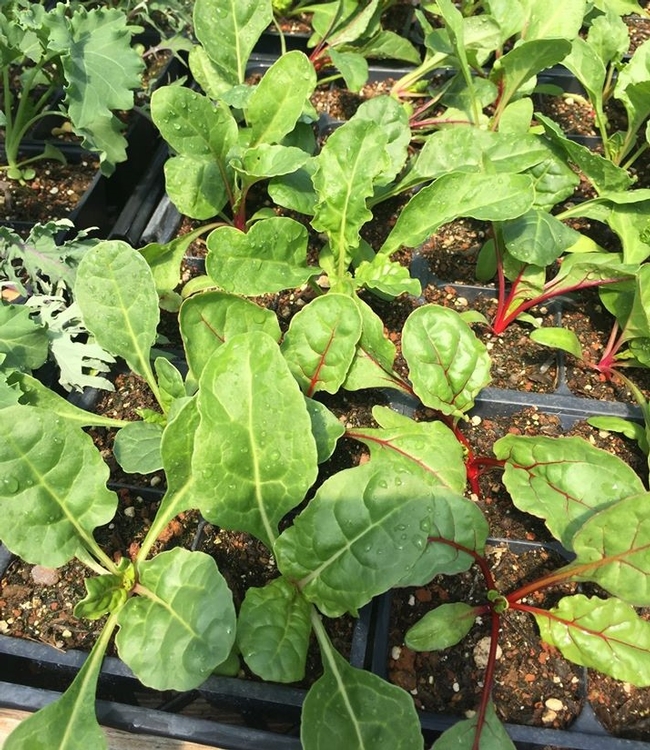
Both farmers saw an increase in farm stand business during the pandemic, which Yagi attributed to the “traffic storm of people” who attended their annual plant sale fundraiser and came to participate in new farm outdoor activities and volunteer opportunities. Yagi also noted the growing number of low-income individuals who were unable to access fresh produce during the pandemic.
The speakers' shared experiences running successful farm stands gave audience members tangible examples and real-time information on how to incorporate farm stands into their businesses.
Carmen Snyder of Sonoma County Farm Trails, which helped circulate the recorded webinars to their network of farmers and ranchers, remarked: “These webinars were extremely helpful for local producers, to get clarity on best pandemic practices during these challenging times and to learn how other producers are adapting and navigating the circumstances.”


